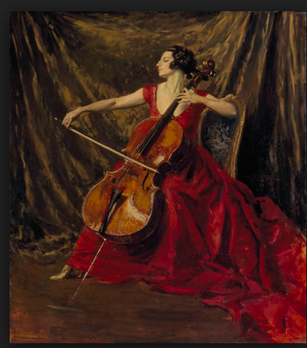|
3/27/2017 2 Comments Bows, Strings and a Sheep A week ago I dropped in on Benny Frankfurth, "our" luthier and piano tuner in Vejle, www.pianohuset.dk His shop is where I bought my cello several years ago (the best I've ever played) and where Giuly bought her violin (119 years old). We always go there when we need a small adjustment, strings or other things, and we can warmly recommend it. His shop doesn't look big from the street - but don't be fooled: it is very deep and filled with pianos, violins, guitars, cellos and all things related. The reason why I came there last week was my bow in need of repair, and I had an extremely interesting visit! First, he said my bow needed rehairing - he compared it to another one he had, and yes, I could see there were only half as many hairs left on the bow. No wonder I thought I could only play softly! ;-) Then he said there was a difference in hair quality: there were Chinese, Siberian and Mongolian horse-hairs (the best type). He said he'd put Mongolian hairs on it, and I'm really looking forward to it! We'd got some bows on a trial period, which had been very interesting. It's incredible how different bows can feel to play with! The one I tried was very light to play with, the tone was big - but the sound wasn't the one I was looking for. It was a very good bow, but destined for another cello than mine. But a bow isn't the only thing that sounds different from cello to cello!  Strings, too, can sound very differently. A string that sounds wonderful on one instrument can sound bland on another. Not to mention gut strings vs. steel! Today, most musicians use steel, because they (apparently) have a more brilliant, powerful tone and are more stable and long-lasting. But in earlier times strings of sheep's gut were used (but were called catgut - yes, very confusing. Perhaps they did use cats once upon a time - sorry, I'll stop now!) Anyway, I asked Benny about the difference between steel and gut. And yes, there is something about steel being more reliable and perhaps also has a bigger tone. But I got a gut string to take home with me to try out the sound, and I absolutely love it. The sound is much more velvety, and yes, I didn't manage to get as much sound out of it as from the other strings, but suddenly the other strings sounded rather harsh and metallic.  Then a girl came in who was looking for a cello as a confirmation present for next year. She was a bit too shy to try the instruments out herself, so I was allowed to play them for her. That was great fun! I love listening to the different sounds, and feel how different they are to play. But I did not say much about them because I wanted her to decide on which sound and instrument she preferred. Because it's going to be her cello, not mine, and so she should be happy with the tone, and that's not my decision. I tried several good cellos there, and I learned that nothing is static regarding an instrument. The sound changes too; the cello needs "playing in" - a bit like shoes, really. So I cannot judge a cello just by trying it once; I have to play it over time - and if I play beautifully, the sound will improve, too. I could go on for ages yet. There was so much I learned, and I could have stayed longer - but I had to catch a bus, and Benny was closing the shop for the day. But thank you for taking so much time for me! I am really looking forward to come again. Best wishes Anna
2 Comments
|
BlogWritten in turn by Maria, Anna and Giuly. Mostly music related posts, but there may also be the occasional cake recipe.... Archives
September 2017
Categories |
 RSS Feed
RSS Feed